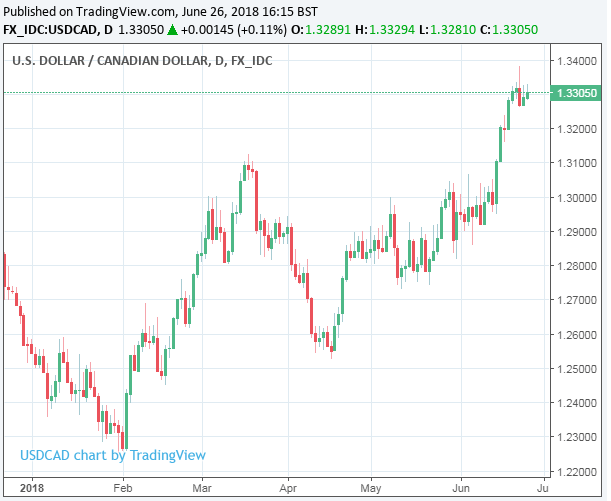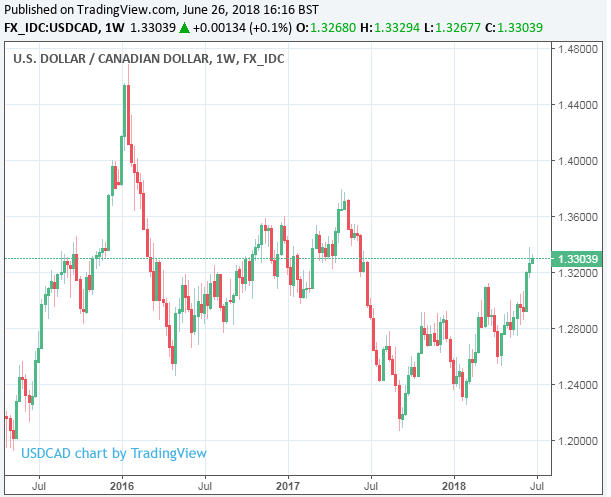Canadian Dollar Eyes Break of 1.35 Level after NAFTA Story Goes from Bad to Worse
- Written by: James Skinner
-

© Shealah Craighead, The White House
The Canadian Dollar is on the verge of another leg down that could see it reach fresh multi-year lows against the US Dollar in the weeks ahead, according to strategists at Toronto-based TD Securities, given that news related to the North American Free Trade Agreement (NAFTA) negotiations is going from bad to worse on a near-daily basis.
Financial markets had slowly but surely resigned themselves in recent months to the idea that slow progress would mean a deal to save NAFTA is unlikely to come much before year-end. However, the latest trade-related rhetoric to come from President Donald Trump has now placed the subject of an outright US withdrawal from the pact on the table.
"The CAD story (#badforcad) is spiralling into a negative feedback loop that sees little prospects of breaking anytime soon. Trade tensions and NAFTA tape bombs are the fastest growing risks, leaving the loonie sensitive to the sticker shock from Trump's twitter account. By the same token, data and the macro outlook have turned increasingly negative as well," says Mark McCormick, North American head of FX strategy at TD Securities.
President Trump suggested Tuesday that US officials are close to having finished their section 232 investigation into whether the current automotive industry landscape presents a threat to national security. This 232 investigation is the same pretext used by the Trump administration to impose tariffs on imports of steel and aluminium into the US, which have now been levied against both Canada and Mexico.
....We are finishing our study of Tariffs on cars from the E.U. in that they have long taken advantage of the U.S. in the form of Trade Barriers and Tariffs. In the end it will all even out - and it won’t take very long!
— Donald J. Trump (@realDonaldTrump) 26 June 2018
Originally aimed at China, the decision to levy tariffs against metals imported from Canada and the EU led to retaliatory measures from both Ottawa and Brussels and has been credited with sparking now-growing fears in financial markets over a so called "trade war".
The 232 investigation into automotives has important implications for Canada as well as the European Union because many EU car manufacturers currently use Mexico as a North American manufacturing base, from where they ship finished cars into the United States. Canada is also a popular location for the manufacture of trucks and lorries.
"We view this probe as leverage around the NAFTA negotiations after talks stalled a week earlier, as well as a response to the EU's retaliatory threats," McCormick adds.
McCormick and the TD team cite President Trump's rising approval rating and a strong US economy as grounds for thinking the White House could become more confrontational on the trade front during the months ahead and as the November midterm elections draw closer. And by implication, this is why the Canadian Dollar could be vulnerable to further losses.

Above: USD/CAD rate shown at daily intervals.
"Canada's continued defiant stance on Trump's trade tactics may enjoy domestic support in the near-term, but if the US inflicts enough economic pain the Canadian negotiating position will look more and more tenuous. Meanwhile, it's a safe bet that Trump will continue to play by his own rules: aiming high, using leverage, staying in the press, and fighting back," McCormick writes, in a recent briefing to clients.
US and Canadian officials have been attempting to save the NAFTA pact, which enables tariff free trade between the US, Canada and Mexico, through intensive negotiations for close to a year now. President Donald Trump called it "the worst deal in history" when on the campaign trail and pledged to withdraw from it if the US cannot negotiate terms more agreeable to the new administration.
TD Securities analysts have previously estimated that a US withdrawal from NAFTA could see the Canadian Dollar fall by 20% as markets would be forced to mark down their expectations for Canadian economic growth and interest rates over the longer term. It is possible markets are not waiting for a US withdrawal announcement before taking action, given the USD/CAD rate has risen by 5.8% already in 2018.
"CAD's return profile remains asymmetrically skewed to the downside with the risk of a trade war still being underappreciated. The recent run-up in USDCAD is consistent with our High-Frequency-Fair-Value estimate, suggesting that there is still room for the pair to price in a risk premium. We continue to look higher as the path of least resistance for USDCAD," McCormick says.

Above: USD/CAD rate shown at weekly intervals.
The impact that NAFTA uncertainty can have on market expectations for Bank of Canada monetary policy is its most potent influence over the Canadian Dollar. Markets have been looking for two more rate hikes from the Bank of Canada before year-end, with one in July and the other in the final quarter.
However, if doubts over the future of the trade pact grow during the months ahead, or if the US goes ahead and declares its intention to withdraw from the deal, then markets could quick soon pricing in a slower pace of interest rate rises, or even rate cuts.
Changes in rates, or hints of them being in the cards, impact currencies because of the push and pull influence they have on international capital flows and their allure for short-term speculators.
"Disentangling NAFTA risks and the outlook for the BoC is as close as it gets to being stuck between a rock and a hard place," says McCormick. "The recent move in USDCAD over the past month is fully explained by the model so the rally has been matched by deteriorated fundamentals. New (negative) information leaves room for the pair to push higher. We have no qualms about a return to 1.35 before reassessing spot's risk/return profile."
The USD/CAD rate was quoted 0.04% higher at 1.3305 Tuesday and has risen 5.8% in 2018. The Pound-to-Canadian-Dollar rate on the other hand, was down 0.19% at 1.7621 but has risen 4.04% in 2018.
Advertisement
Get up to 5% more foreign exchange by using a specialist provider to get closer to the real market rate and avoid the gaping spreads charged by your bank when providing currency. Learn more here









